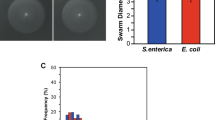Summary
In Salmonella typhimurium, more than 40 genes have been shown to be involved in flagellar formation and function and almost all of them have been assigned to three regions of the chromosome, termed region I, region II, and region III. In the present study, a large number of transposon-insertion mutants in these flagellar genes were isolated using Tn10 and Mud1. The flaV gene was found to be a strong hot spot for Tn10 insertion. Complementation analysis of the polarity effects exerted by the transposon-insertion mutants defined 13 different flagellar operons; 3 in region I, 4 in region II, and 6 in region III. These results are compared with the reported arrangement of the corresponding genes in Escherichia coli.
Similar content being viewed by others
References
Blazey DL, Burns RO (1982) Transcriptional activity of the transposable element Tn10 in the Salmonella typhimurium ilvGEDA operon. Proc Natl Acad Sci USA 79:5011–5015
Casadaban MJ, Cohen SN (1979) Lactose genes fused to exogenous promoters in one step using a Mu-lac bacteriophage: In vivo probe for transcriptional control sequences. Proc Natl Acad Sci USA 76:4530–4533
Ciampi MS, Schmid MB, Roth JR (1982) Transposon Tn10 provides a promoter for transcription of adjacent sequences. Proc Natl Acad Sci USA 79:5016–5020
Csonka LN, Howe MM, Ingraham JL, Pierson III LS, Turnbough Jr CL (1981) Infection of Salmonella typhimurium with coliphage Mud1 (Apr lac): Construction of pyr::lac gene fusions. J Bacteriol 145:299–305
Davis RW, Botstein D, Roth JR (1980) Quick method for the preparation of P22 transducing phage. In: Davis RW, Botstein D, Roth JR (eds) Advanced bacterial genetics. Cold Spring Harbor Laboratory Press, Cold Spring Harbor, New York, pp 78–79
DeFranco AL, Koshland Jr DE (1981) Molecular cloning of chemotaxis genes and overproduction of gene products in the bacterial sensing system. J Bacteriol 147:390–400
DeFranco AL, Parkinson JS, Koshland Jr DE (1979) Functional homology of chemotaxis genes in Escherichia coli and Salmonella typhimurium. J Bacteriol 139:107–114
Fujita H, Yamaguchi S, Iino T (1973) Studies on H-O variants in Salmonella in relation to phase variation. J Gen Microbiol 76:127–134
Halling SM, Kleckner N (1982) A symmetrical six-base-pair target site sequence determines Tn10 insertion specificity. Cell 28:155–163
Homma M, Iino T, Macnab RM (1988) Identification and characterization of the products of six region III flagellar genes (flaAII.3 through flaQII) of Salmonella typhimurium. J Bacteriol 170:2221–2228
Kleckner N, Roth J, Botstein D (1977) Genetic engineering in vivo using transposable drug-resistance elements. J Mol Biol 116:125–159
Komeda Y (1982) Fusions of flagellar operons to lactose genes on a Mu lac bacteriophage. J Bacteriol 150:16–26
Komeda Y, Kutsukake K, Iino T (1980) Definition of additional flagellar genes in Escherichia coli K12. Genetics 94:277–290
Konno R, Fujita H, Horiguchi T, Yamaguchi S (1976) Precise position of the nml locus on the genetic map of Salmonella. J Gen Microbiol 93:182–184
Kutsukake K, Iino T (1985) Refined genetic analysis of the region II che mutants in Salmonella typhimurium. Mol Gen Genet 199:406–409
Kutsukake K, Suzuki T, Yamaguchi S, Iino T (1979) Role of gene flaFV on flagellar hook formation in Salmonella typhimurium. J Bacteriol 140:267–275
Kutsukake K, Iino T, Komeda Y, Yamaguchi S (1980) Functional homology of fla genes between Salmonella typhimurium and Escherichia coli. Mol Gen Genet 178:59–67
Lee SY, Butler D, Fleckner N (1987) Efficient Tn10 transposition into a DNA insertion hot spot in vivo requires the 5-methyl groups of symmetrically disposed thymines within the hot-spot consensus sequence. Proc Natl Acad Sci USA 84:7876–7880
Macnab RM (1987) Flagella. In: Neidhardt FC (ed) Escherichia coli and Salmonella typhimurium. American Society for Microbiology, Washington, DC, pp 70–83
Ornellas EP, Stocker BAD (1974) Relation of lipopolysaccharide character to P1 sensitivity in Salmonella typhimurium. Virology 60:491–502
Russo AF, Koshland Jr DE (1986) Identification of the tip-encoded receptor in bacterial sensing. J Bacteriol 165:276–282
Schmieger H (1972) Phage P22 mutants with increased or decreased transduction abilities. Mol Gen Genet 119:75–88
Silverman M, Simon M (1973) Genetic analysis of bacteriophage Mu-induced flagellar mutants in Escherichia coli. J Bacteriol 116:114–122
Simons RW, Hoopes BC, McClure WR, Kleckner N (1983) Three promoters near the termini of IS10: pIN, pOUT, and pIII. Cell 34:673–682
Slocum MK, Parkinson JS (1983) Genetics of methyl-accepting chemotaxis proteins in Escherichia coli: Organization of the tar region. J Bacteriol 155:565–577
Suzuki T, Komeda Y (1981) Incomplete flagellar structures in Escherichia coli mutants. J Bacteriol 145:1036–1041
Yamaguchi S, Fujita H, Taira T, Kutsukake K, Homma M, Iino T (1984) Genetic analysis of three additional fla genes in Salmonella typhimurium. J Gen Microbiol 130:3339–3342
Yamaguchi S, Fujita H, Ishihara A, Aizawa S, Macnab RM (1986a) Subdivision of flagellar genes of Salmonella typhimurium into regions responsible for assembly, rotation, and switching. J Bacteriol 166:187–193
Yamaguchi S, Aizawa S, Kihara M, Isomura M, Jones CJ, Macnab RM (1986b) Genetic evidence for a switching and energy-transducing complex in the flagellar motor of Salmonella typhimurium. J Bacteriol 168:1172–1179
Author information
Authors and Affiliations
Additional information
Communicated by K. Isono
Rights and permissions
About this article
Cite this article
Kutsukake, K., Ohya, Y., Yamaguchi, S. et al. Operon structure of flagellar genes in Salmonella typhimurium . Mol Gen Genet 214, 11–15 (1988). https://doi.org/10.1007/BF00340172
Received:
Issue Date:
DOI: https://doi.org/10.1007/BF00340172




